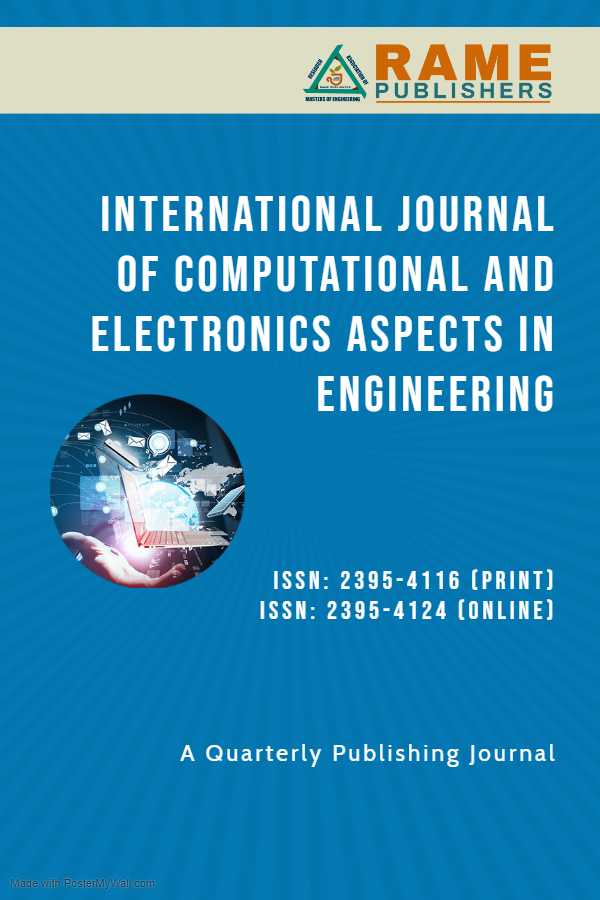Comparative Evaluation of Resnet-50 and Efficientnet-B1 for Pneumonia Detection in Chest X-Ray Images Using Transfer Learning
Najwan Waisi
International Journal of Computational and Electronic Aspects in Engineering
Volume 6: Issue
2, June 2025, pp 89-97
Author's Information
Najwan Waisi 1
Corresponding Author
1Department of Computer Engineering, Northern Technical University, Mosul, Iraq
najwan.tuhafi@ntu.edu.iq
Abstract:-
In this paper, Prompt and reliable identification of pneumonia particularly during widespread outbreaks like COVID-19 remains a pressing concern in modern healthcare. Recently, deep learning techniques have emerged as effective support tools for radiologists, aiding in the automated interpretation of chest X-ray CXR images for thoracic disease diagnosis. This study offers a comparative evaluation of two convolutional neural network CNN models, ResNet-50 and EfficientNet-B1, for the classification of pneumonia cases, including those caused by COVID-19, using transfer learning strategies. Both networks were initialized with ImageNet pre-trained weights and subsequently fine-tuned on a curated dataset comprising normal, pneumonia, and COVID-19 positive CXR samples. Image preprocessing and augmentation methods were employed to improve generalization. Performance was assessed using key metrics such as accuracy sensitivity specificity and computational efficiency results indicate that EfficientNet-B1 achieves superior performance with a classification accuracy of 96% compared to 94% for ResNet-50, along with higher sensitivity and reduced inference time. Grad-CAM visualizations confirmed that EfficientNet-B1 provided more clinically relevant localization of diseased regions. Overall EfficientNet-B1 demonstrates strong potential for real time diagnostic use in low resource healthcare settings and highlights the importance of model selection in AI driven medical imaging applications.Index Terms:-
Pneumonia classification; Chest X-ray; Deep learning, ResNet-50, EfficientNet-B1.REFERENCES
- Khan, Saif Ur Rehman. "Multi-level feature fusion network for kidney disease detection." Computers in Biology and Medicine 191 (2025): 110214.
- Kumar, Sahil. "Early Disease Detection Using AI: A Deep Learning Approach to Predicting Cancer and Neurological Disorders." International Journal of Scientific Research and Management (IJSRM) 13.04 (2025): 2136-2155.
- Yasin, Hajar Maseeh. "Pneumonia and COVID-19 classification and detection based on convolutional neural network: A review." Asian Journal of Research in Computer Science 18.1 (2025): 174-183.
- Saleh, Redeer Avdal, and Subhi RM Zeebaree. "Artificial Intelligence in E-commerce and Digital Marketing: A Systematic Review of Opportunities, Challenges, and Ethical Implications." Asian Journal of Research in Computer Science 18 (2025): 395-410.
- Saleh, Redeer Avdal, and Hajar Maseeh Yasin. "Comparative Analysis of AI and Machine Learning Applications in Modern Database Systems." (2025).
- Paschaloudi, Vasileia, Dimitris Fotopoulos, and Ioanna Chouvarda. "Radiomics for Machine Learning—A Multi-Class System for the Automatic Detection of COVID-19 and Community-Acquired Pneumonia from Computed Tomography Images." BioMedInformatics 5.2 (2025).
- Jia, Ran, et al. "Immunological landscape of children with Mycoplasma pneumoniae pneumonia in the post-COVID-19 era reveals distinctive severity indicators." Respiratory Research 26.1 (2025): 103.
- Lamouadene, Hajar, et al. "Detection of COVID-19, lung opacity, and viral pneumonia via X-ray using machine learning and deep learning." Computers in Biology and Medicine 191.11013 (2025): 1.
- Mao, Siqi, Saltanat Kulbayeva, and Mikhail Osadchuk. "Chest x‐ray images: transfer learning model in COVID‐19 detection." Journal of Evaluation in Clinical Practice 31.1 (2025): e14215.
- Thabit, Qabeela Q., Bayadir A. Issa, and Alyaa I. Dawood. "Detection of Pneumonia by Combining Transfer Learning Models with Data." Proceedings of Data Analytics and Management: ICDAM 2024, Volume 3 1299 (2025): 129.
- Lamouadene, Hajar, et al. "Detection of COVID-19, lung opacity, and viral pneumonia via X-ray using machine learning and deep learning." Computers in Biology and Medicine 191.11013 (2025).
- Dharmik, Anjali. "COVID 19 Diagnosis Analysis using Transfer Learning." arXiv preprint arXiv:2503.12642 (2025).
- Geroski, Tijana, et al. "Enhancing COVID-19 disease severity classification through advanced transfer learning techniques and optimal weight initialization schemes." Biomedical Signal Processing and Control 100 (2025): 107103.
- Mallick, Devanshi, et al. "Classifying chest x-rays for COVID-19 through transfer learning: a systematic review." Multimedia Tools and Applications 84.2 (2025): 689-748.
- Singh, Kuljeet, et al. "Deep CP-CXR: A Deep Learning Model for Classification of Covid-19 and Pneumonia Disease Using Chest X-Ray Images." Annals of Data Science (2025): 1-24.
- Kumar, Sunil, and Biswajit Bhowmik. "EffiCOVID-Net: A Highly Efficient Convolutional Neural Network for COVID-19 Diagnosis Using Chest X-ray Imaging." Methods (2025).
- Geetha, A., et al. "DEEP GD: Deep learning based snapshot ensemble CNN with EfficientNet for glaucoma detection." Biomedical Signal Processing and Control 100 (2025): 106989.
- Çiçek, Yasin, et al. "Classifying Weed Development Stages Using Deep Learning Methods: Classifying Weed Development Stages with DenseNET, Xception, SqueezeNET, GoogleNET, EfficientNET CNN Models Using ROI Images." International Journal of Advanced Computer Science & Applications 16.2 (2025).
- Arnob, Asif Shahriar, et al. "Comparative result analysis of cauliflower disease classification based on deep learning approach VGG16, inception v3, ResNet, and a custom CNN model." Hybrid Advances 10 (2025): 100440.
- Srivastava, Rakesh, Nitish Kumar, and Tushar Sandhan. "Binary Classification of Laryngeal Images Utilising ResNet-50 CNN Architecture." Indian Journal of Otolaryngology and Head & Neck Surgery 77.2 (2025): 644-651.
- Sakirin, Tam, and Rachid Ben Said. "Application of Deep Learning and Transfer Learning Techniques for Medical Image Classification." EDRAAK 2025 (2025): 38-46.
- Choudhry, Imran Arshad, et al. "Transforming Lung Disease Diagnosis With Transfer Learning Using Chest X‐Ray Images on Cloud Computing." Expert Systems 42.2 (2025): e13750.
- Cahyani, Denis Eka, et al. "lung diseases identification using hybrid transfer learning and bidirectional long short-term memory." Bulletin of Electrical Engineering and Informatics 14.2 (2025): 1418-1427.
- Sairam, M. V. S., and Raju Egala. "Transfer Learning-Based Convolutional Neural Network for Six-Class Lung Disease Classification."
- Mirzaee, Ashraf, and Parviz Ghorbanzadeh. "Performance Evaluation and Comparison of Transfer Learning Models in Chest X-Ray Image Classification Using Deep Neural Networks." Management Strategies and Engineering Sciences 7.4 (2025): 33-40.
To view full paper, Download here
To View Full Paper
For authors
Author's guidelines Publication Ethics Publication Policies Artical Processing Charges Call for paper Frequently Asked Questions(FAQS) View All Volumes and IssuesPublishing with




